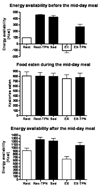Nonhomeostatic control of human appetite and physical activity in regulation of energy balance
- PMID: 20577059
- PMCID: PMC2943207
- DOI: 10.1097/JES.0b013e3181e3728f
Nonhomeostatic control of human appetite and physical activity in regulation of energy balance
Abstract
Ghrelin and leptin, putative controllers of human appetite, have no effect on human meal-to-meal appetite but respond to variations in energy availability. Nonhomeostatic characteristics of appetite and spontaneous activity stem from inhibition by leptin and ghrelin of brain reward circuit that is responsive to energy deficit, but refractory in obesity, and from the operation of a meal-timing circadian clock.
Figures







Comment in
-
Why doesn't weight gain blunt appetite and increase movement? Nonhomeostatic responses to energy surplus in humans.Exerc Sport Sci Rev. 2010 Jul;38(3):103-4. doi: 10.1097/JES.0b013e3181e37419. Exerc Sport Sci Rev. 2010. PMID: 20577057 No abstract available.
References
-
- Adolph EF. Urges to eat and drink in rats. Amer J Physiol. 1947;151:110–125. - PubMed
-
- Black AE, Coward WA, Cole TJ, Prentice AM. Human energy expenditure in affluent societies: an analysis of 574 doubly-labelled water measurements. Eur J Clin Nutr. 1996;50:72–92. - PubMed
-
- Campbell BA, Fibiger HC. Effects of insulin on spontaneous activity during food deprivation. J Comp Physiol Psychol. 1970;71:341–346. - PubMed
Publication types
MeSH terms
Substances
Grants and funding
LinkOut - more resources
Full Text Sources

